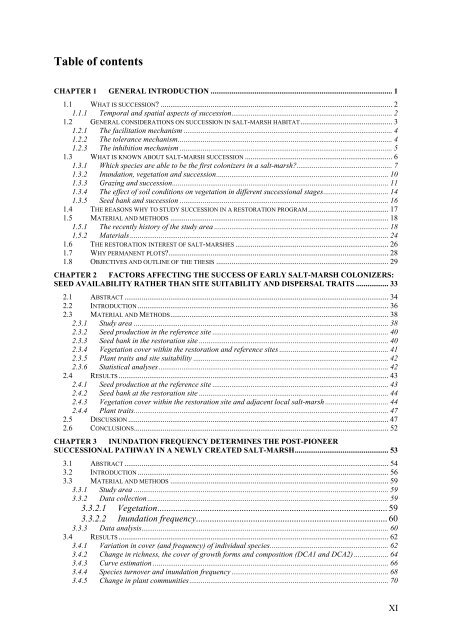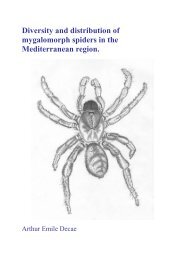PhD Reza Erfanzadeh 2009 - Ghent Ecology - Universiteit Gent
PhD Reza Erfanzadeh 2009 - Ghent Ecology - Universiteit Gent
PhD Reza Erfanzadeh 2009 - Ghent Ecology - Universiteit Gent
Create successful ePaper yourself
Turn your PDF publications into a flip-book with our unique Google optimized e-Paper software.
Table of contents<br />
CHAPTER 1 GENERAL INTRODUCTION ............................................................................................... 1<br />
1.1 WHAT IS SUCCESSION? ......................................................................................................................... 2<br />
1.1.1 Temporal and spatial aspects of succession.................................................................................... 2<br />
1.2 GENERAL CONSIDERATIONS ON SUCCESSION IN SALT-MARSH HABITAT................................................ 3<br />
1.2.1 The facilitation mechanism ............................................................................................................. 4<br />
1.2.2 The tolerance mechanism................................................................................................................ 4<br />
1.2.3 The inhibition mechanism ............................................................................................................... 5<br />
1.3 WHAT IS KNOWN ABOUT SALT-MARSH SUCCESSION ............................................................................. 6<br />
1.3.1 Which species are able to be the first colonizers in a salt-marsh?.................................................. 7<br />
1.3.2 Inundation, vegetation and succession.......................................................................................... 10<br />
1.3.3 Grazing and succession................................................................................................................. 11<br />
1.3.4 The effect of soil conditions on vegetation in different successional stages.................................. 14<br />
1.3.5 Seed bank and succession ............................................................................................................. 16<br />
1.4 THE REASONS WHY TO STUDY SUCCESSION IN A RESTORATION PROGRAM.......................................... 17<br />
1.5 MATERIAL AND METHODS .................................................................................................................. 18<br />
1.5.1 The recently history of the study area ........................................................................................... 18<br />
1.5.2 Materials ....................................................................................................................................... 24<br />
1.6 THE RESTORATION INTEREST OF SALT-MARSHES ................................................................................ 26<br />
1.7 WHY PERMANENT PLOTS?................................................................................................................... 28<br />
1.8 OBJECTIVES AND OUTLINE OF THE THESIS .......................................................................................... 29<br />
CHAPTER 2 FACTORS AFFECTING THE SUCCESS OF EARLY SALT-MARSH COLONIZERS:<br />
SEED AVAILABILITY RATHER THAN SITE SUITABILITY AND DISPERSAL TRAITS ................. 33<br />
2.1 ABSTRACT .......................................................................................................................................... 34<br />
2.2 INTRODUCTION ................................................................................................................................... 36<br />
2.3 MATERIAL AND METHODS.................................................................................................................. 38<br />
2.3.1 Study area ..................................................................................................................................... 38<br />
2.3.2 Seed production in the reference site ............................................................................................ 40<br />
2.3.3 Seed bank in the restoration site ................................................................................................... 40<br />
2.3.4 Vegetation cover within the restoration and reference sites ......................................................... 41<br />
2.3.5 Plant traits and site suitability ...................................................................................................... 42<br />
2.3.6 Statistical analyses........................................................................................................................ 42<br />
2.4 RESULTS ............................................................................................................................................. 43<br />
2.4.1 Seed production at the reference site ............................................................................................ 43<br />
2.4.2 Seed bank at the restoration site ................................................................................................... 44<br />
2.4.3 Vegetation cover within the restoration site and adjacent local salt-marsh ................................. 44<br />
2.4.4 Plant traits..................................................................................................................................... 47<br />
2.5 DISCUSSION ........................................................................................................................................ 47<br />
2.6 CONCLUSIONS..................................................................................................................................... 52<br />
CHAPTER 3 INUNDATION FREQUENCY DETERMINES THE POST-PIONEER<br />
SUCCESSIONAL PATHWAY IN A NEWLY CREATED SALT-MARSH................................................. 53<br />
3.1 ABSTRACT .......................................................................................................................................... 54<br />
3.2 INTRODUCTION ................................................................................................................................... 56<br />
3.3 MATERIAL AND METHODS .................................................................................................................. 59<br />
3.3.1 Study area ..................................................................................................................................... 59<br />
3.3.2 Data collection.............................................................................................................................. 59<br />
3.3.2.1 Vegetation..................................................................................................... 59<br />
3.3.2.2 Inundation frequency.................................................................................... 60<br />
3.3.3 Data analysis................................................................................................................................. 60<br />
3.4 RESULTS ............................................................................................................................................. 62<br />
3.4.1 Variation in cover (and frequency) of individual species.............................................................. 62<br />
3.4.2 Change in richness, the cover of growth forms and composition (DCA1 and DCA2) .................. 64<br />
3.4.3 Curve estimation ........................................................................................................................... 66<br />
3.4.4 Species turnover and inundation frequency .................................................................................. 68<br />
3.4.5 Change in plant communities........................................................................................................ 70<br />
XI










